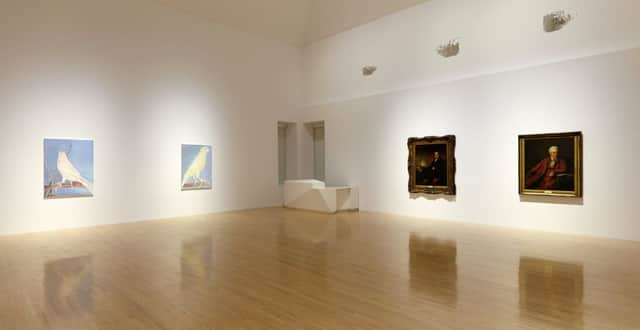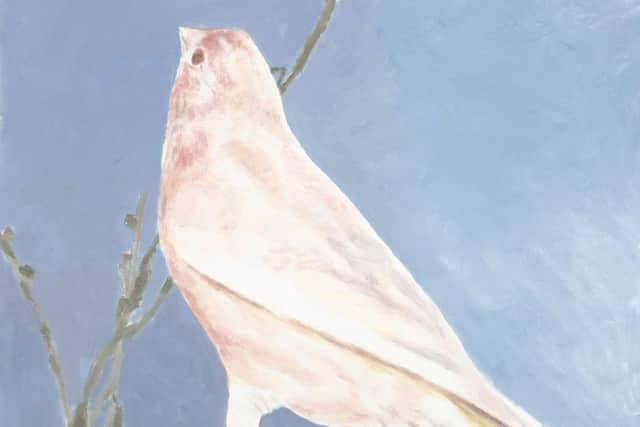Art review: Luc Tuymans: Birds of a Feather, Edinburgh


Luc Tuymans: Birds of a Feather | Rating: ***
Talbot Rice Gallery, Edinburgh
History weighs heavy on Luc Tuymans, an artist who has never shied away from such grim subjects as the Holocaust, anti-Semitism or Belgium’s brutal colonial role in the Congo. His is an oblique and muted art and one that has consistently revealed the insurmountable gap between the horror of events and the banality of their representation.


And if it’s not enough doing your everyday job in the studio, Tuymans also has to live up to being proclaimed a veritable saviour of his chosen medium. The Belgian painter, who was born in 1958 and lives in Antwerp, was widely credited with spearheading the revival of serious painting in the 1990s.
Advertisement
Hide AdAdvertisement
Hide AdDoes Tuymans have faith in paint? It’s hard to tell. He is amongst its fiercest critics, its most ambivalent practitioners and its most consistent champions. A critic once described his art as “infected”: his paintings have a sickly cast, an anxious, polluted edge.
The artist himself has broad shoulders though: last month he opened a juggernaut of a show in Qatar: a 150-painting retrospective covering some 30 years of his career. Soon he will curate an exhibition of the work of the great fin de siècle Belgian painter James Ensor, as though measuring himself, or perhaps being measured against, an important precursor.
In the meantime in a compact exhibition, at the invitation of Pat Fisher at the University of Edinburgh’s Talbot Rice Gallery, Tuymans shows his work against three outstanding 18th century portraits by the Scottish artist Henry Raeburn from the university’s own collection.
It’s not entirely incongruous. The artist first encountered Raeburn’s work as a teenager when he came across the Edinburgh artist’s portrait of Alexander Edgar in The Museum of Fine Art in Ghent. Tuymans has said that he is fascinated both by Raeburn’s historical realism and his frank brushwork and economy of means.
This does not mean, however, that he seeks to emulate him. His response, in a show entitled Birds of a Feather, is a series of three large new paintings depicting prize canaries. They are disconcerting enough that we might listen carefully for clues to what is being said. What might these three stiff birds, painted from a photographic guide to canary breeding, tell us about the act of painting, about the nature of the portrait and about the grand narrative of enlightenment European thinking that Raeburn represents?
In the main gallery Tuymans has hung three handsome Raeburn portraits. They are William Robertson, Scottish historian, church minister and university principal; John Playfair, the scientist and mathematician and John Robison, the physicist and mathematician. They are clever men for clever times: their science grounded in the disciplines of observation and empiricism.
Tuymans has always painted from photography, indeed in the 1980s he gave up paint for film, returning to the studio with a cinematic understanding of picture-making.
His three large canary paintings Border Fancy, Isabel and Orange Red Brown, show dead-eyed birds on branches, against blue studio settings. The birds are types, each representative of their breed. The puffed up men of science reduced from rational individuals to shadowy specimens. But bird breeding may also be a far more pessimistic metaphor. The optimistic rationalism of 18th century empiricism concluded in the age of eugenics, of breeding and social engineering.
Advertisement
Hide AdAdvertisement
Hide AdUpstairs the gallery is following what has become something of a tradition: a series of displays give some clue as to the artist’s methods. I would have preferred to see more new paintings instead, but this is a tried and tested formula at Talbot Rice, which places an emphasis on the university’s educational role.
In this case, there is a vitrine of preparatory works and studio photographs. We see a small cardboard studio model of a recording studio, transformed into Polaroid prints that will later become paintings. A tiny drumkit first crafted from paper has been reworked in metal. A work that started as a painting of the wax model of the philosopher Jeremy Bentham is presented as an “artist’s reproduction” in other words a fake of a fake.
What does this add up to? A conviction that nothing is true, that images are staged for the camera and for the brush, that there is no such thing as a genuine artefact. Earlier this year Tuymans was sued for breach of copyright, in relation to a painting he made of a Belgian politician from the work of photographer Katrijn van Giel. You are reminded that long before this controversy the artist once described his own works as “authentic forgeries”
You note too these are images of silence: downstairs those canaries are mute. Raeburn might have believed that paint could speak of flesh and bone, that through optical means we night access psychological insight. Tuymans’ proposition is just the opposite, if a painting can’t speak truly about the world, we might just have to fill the silence ourselves.
Until 19 December. Read Jackie McGlone’s interview with Luc Tuymans